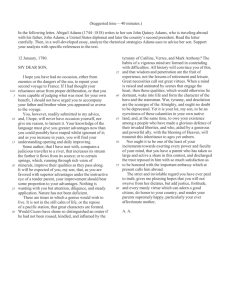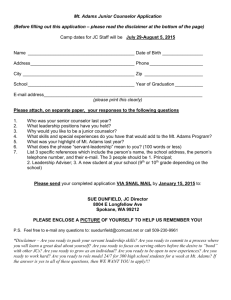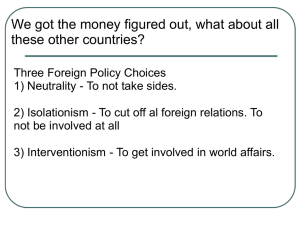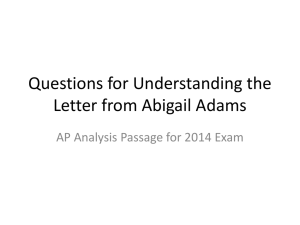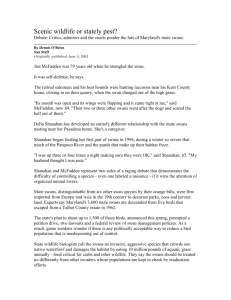“Passenger Pigeons and Black Swans”
advertisement
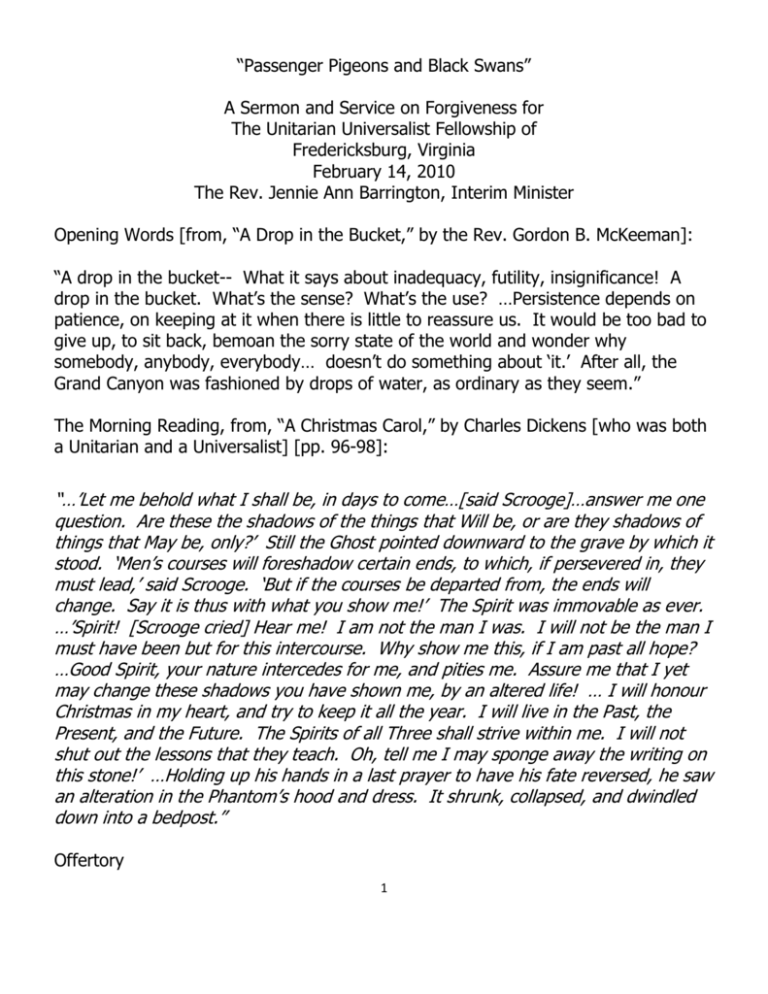
“Passenger Pigeons and Black Swans” A Sermon and Service on Forgiveness for The Unitarian Universalist Fellowship of Fredericksburg, Virginia February 14, 2010 The Rev. Jennie Ann Barrington, Interim Minister Opening Words [from, “A Drop in the Bucket,” by the Rev. Gordon B. McKeeman]: “A drop in the bucket-- What it says about inadequacy, futility, insignificance! A drop in the bucket. What’s the sense? What’s the use? …Persistence depends on patience, on keeping at it when there is little to reassure us. It would be too bad to give up, to sit back, bemoan the sorry state of the world and wonder why somebody, anybody, everybody… doesn’t do something about ‘it.’ After all, the Grand Canyon was fashioned by drops of water, as ordinary as they seem.” The Morning Reading, from, “A Christmas Carol,” by Charles Dickens [who was both a Unitarian and a Universalist] [pp. 96-98]: “…’Let me behold what I shall be, in days to come…[said Scrooge]…answer me one question. Are these the shadows of the things that Will be, or are they shadows of things that May be, only?’ Still the Ghost pointed downward to the grave by which it stood. ‘Men’s courses will foreshadow certain ends, to which, if persevered in, they must lead,’ said Scrooge. ‘But if the courses be departed from, the ends will change. Say it is thus with what you show me!’ The Spirit was immovable as ever. …’Spirit! [Scrooge cried] Hear me! I am not the man I was. I will not be the man I must have been but for this intercourse. Why show me this, if I am past all hope? …Good Spirit, your nature intercedes for me, and pities me. Assure me that I yet may change these shadows you have shown me, by an altered life! … I will honour Christmas in my heart, and try to keep it all the year. I will live in the Past, the Present, and the Future. The Spirits of all Three shall strive within me. I will not shut out the lessons that they teach. Oh, tell me I may sponge away the writing on this stone!’ …Holding up his hands in a last prayer to have his fate reversed, he saw an alteration in the Phantom’s hood and dress. It shrunk, collapsed, and dwindled down into a bedpost.” Offertory 1 Sermon: Valentine’s Day makes me think about marriage. And marriage makes me think about the many covenantal relationships we are in: in our families, friendships, workplaces, and in our congregations-- even in our interconnected relationships to the birds, the trees, and all living things. Many years ago, a friend told me of the one thing that saved her marriage several times, particularly in its early years. She called it, “Fresh Start, Clean Slate.” She and her husband agreed that when they had had a terrible fight [especially due to stressful short-term circumstances, such as their baby screaming from another ear infection], they would begin anew the next day by forgiving each other for the hurtful things they had said. They would start fresh, with a clean slate. She wasn’t saying it was easy, not for either of them. She wasn’t saying they forgot entirely that they had hurt each other. But their promise and practice of forgiveness has kept their marriage alive. That marriage is still going strong after over ten years. What is the recipe for a covenantal relationship that is healthy and sustainable over the course of many years? What are the ingredients? What are the opposites of those ingredients? James Luther Adams, one of the greatest Unitarian Universalist scholars of the twentieth century, calls it a covenant of grace. In his essay, “Prophetic Judgment and Grace,” [James Luther Adams – The Prophethood of All Believers, pp. 59-60], Adams describes the differences between the views of justice professed by the two prophets of the Hebrew Scriptures, Amos and Hosea. Adams believes Hosea’s view is the new and improved one. Adams summarizes Amos’s view as: “Once violation of the covenant has taken place, then from generation to generation the curse is on you.” On the other hand, Adams writes: “Hosea gives you a metaphor… Hosea, you will remember, imagines that Yahweh has a faithless bride. She has violated the covenant. Hosea creates this marvelous picture of the groom who has been betrayed. The groom pursues the faithless violator of the covenant and says, ‘I know what you did! I know what you’ve done! I understand. I know what you will do. Don’t you understand? I love you nevertheless!’ …The idea of forgiveness, taken alone [Adams writes], is another form of idolatry, because forgiveness has to be related, somehow, to the creative maintenance of justice. This creative principle is heard in Hosea. Hosea is asserting that you have to understand the covenant as providing the occasion, through the remaking of the covenant, for new beginnings. If you have only a doctrine of justice, or nemesis, there cannot be new beginnings. There is just constant suffering from the violations of the past. Hosea is a great anticipator of Henri 2 Bergson, Whitehead, and others who have emphasized the idea of novelty, the possibility of a new event. In human terms this means that we are not caught in the vise of cause and effect, the past determining the present. It is possible to introduce something new: that is the meaning of the idea of forgiveness. Forgiveness means: what has happened --I won’t say ‘whatever [has happened, Adams writes],’ for judgment is not ruled out-- [but] what has happened in the past shall not completely determine the future. You can make a new covenant; you can renew the commitment and you can start again.” [end of quote] This, to me, is the most hopeful aspect of the human condition: the fact that the future does not have to be completely determined by what has happened in the past. As long as we are alive, the hope remains that we, and others, can change our patterns of behavior; we can do a new thing. We can act in ways that are nurturing, giving, and creative, rather than hurtful, miserly, and destructive. Done patiently, over time, our actions can be healing and salvific. As such, Adams describes the ingredients of a successful covenantal relationship as: forgiveness, justice, novelty, and grace. Defining those ingredients is complicated, as is defining their antonyms. In the best of all possible worlds, they do not exist separately from each other, but blend together in portions fitting to the circumstances at hand. Edwin Friedman, the famous scholar of “family systems theory,” has a name for those different recipes for different circumstances: resiliency, i.e., to be differentiated enough so that the other party and the long-term relationship itself are able to breathe and grow, and not to over-function; yet to be present and giving enough to be able to be helpful. He notes that resiliency requires us to be, emotionally, sometimes closer, sometimes more removed, depending on the circumstances. If we are too emotionally differentiated for too long, we’ll fall out of the relationship and it will expire. Yet when we cultivate the relationship, so long as we don’t over-function, the other party will continue to develop, and so will we. It is easy for any of us to despair that our nurturing, giving, and creative efforts toward developing relationships aren’t making any real difference. Yet in the long run, those efforts make all the difference in the world. This year I’ve had birdfeeders out on my balcony, which has been spiritually enriching and entertaining for me [not to mention for my cat] to watch. But does my nurturing matter to the birds? Or would they have had plenty to eat anyway? My mother bought me a book about birds so I could find out. Feeder Birds - Eastern North America, by Roger Tory Peterson, says [p. 13]: 3 “the feeder can be an important resource during times of duress. When severe snowstorms blanket wild food supplies, the birds will turn to the feeder they have come to know as a food resource. It is during these times of stress that the feeder plays its most vital role. Do not let them down at this point! If it is a storm of long duration, the feeding station may mean the difference of life for some of the more physiologically unprepared birds. The feeder helps many a bird through the hard times, so it is important to be faithful to your feeding once you start.” By sustaining nurturing relationships with birds and other wild animals, we can keep individual ones alive that otherwise may have died because they were too young, too old, too ill, or too disabled to survive without our aid. And we can even prevent species from becoming extinct. My birdfeeder book says that the hobby of birdwatching often heightens a person’s awareness of our interconnectedness to other forms of life, and of humans’ responsibility to be caring stewards of the natural world and its resources. This has certainly been true for me. My simply looking up certain types of birds I have seen on my balcony led me to learn of several types of birds that have become entirely extinct, among them: the Carolina Parakeet, the Ivory-billed Woodpecker, and the Passenger Pigeon. Something in my heart cried out on learning that all Passenger Pigeons had perished. That cry moved me to learn more about them; I found pictures, some of them in color. There was something both sweet and majestic about their delicate heads held elegantly above their pastel-mottled bodies. I am not the only one whose heart has been captured by the story of the Passenger Pigeon’s tragic demise. It has been honored in novels, a movie, an opera, an episode of Star Trek, and in several songs. The Passenger Pigeon became extinct because human beings were neglectful, short-sighted enough to believe there would always be plenty of them, greedy, and cruel. [Some of the ways they were killed feel too gruesome to mention here.] In the 1800s they were used for food, trap shooting, and as agricultural fertilizer. This drastically reduced their numbers. And they needed to flock together in large masses in order to escape predators and to breed, in order to survive. The last surviving Passenger Pigeon died on September 1, 1914. Her name was Martha, after Martha Washington. Cloning of some animals has now become possible, and cloning of some extinct animals [including the woolly mammoth] is now being explored. So I chanced to wonder if any effort had been made to clone the Passenger Pigeon. Again I found that my imagination was not alone in going out in that new direction. Many people are wondering if that would 4 be possible. The Mourning Dove could help such pioneers along that way. It has not been successfully achieved yet. If one day the Passenger Pigeon could be made to flourish again, I dare say that would be a use of novelty at which Bergson, Whitehead, and Adams would be glad. --because the extinction of a party in a relationship, and therefore of any possibility of continuing the relationship, for reasons that are overwhelmingly destructive, is inherently unjust. It can be difficult to conclude whether a decision and action are more destructive or more creative; it could be said that in order to create anything, some things must be destroyed. But human beings certainly have the responsibility to examine intentions behind our decisions and potential ethical outcomes of our actions such that we would not be found to be neglectful, shortsighted, greedy, or cruel. Our decisions and actions should be inherently just, complicated as that is to define. Amartya Sen, in his book, The Idea of Justice, describes two distinct ways “justice” was defined in ancient India: “niti” and “nyana.” “…’niti,’ relates to organizational propriety as well as behavioral correctness, whereas…’nyana,’ is concerned with what emerges and how, and in particular the lives that people are actually able to lead.” [Preface, p. xv] There is “nyana” when people are happy, thriving, and flourishing, particularly people with the least power in that society. Sen also describes the Sanskrit word, “matsyanyaya” which is “justice in the world of fish,” but injustice in the world of human beings. “Matsyanyaya” is when big fish are able to devour little fish. Sen writes: “We are warned that avoiding ‘matsyanyaya’ must be an essential part of justice, and it is crucial to make sure that the ‘justice of fish’ is not allowed to invade the world of human beings. The central recognition here is that the realization of justice in the sense of ‘nyana’ is not just a matter of judging institutions and rules, but of judging the societies themselves. No matter how proper the established organizations might be, if a big fish could still devour a small fish at will, that must be a patent violation of human justice as ‘nyaya.’” [Introduction, pp. 20-21]. It could be said that “nyaya” is an adaptation of “niti” that allows for flexibility, a preferential option for people who are poor or marginalized, and novelty. The concept of novelty is actually difficult for human beings to get our minds around. So says scholar Nassim Nicholas Taleb, in his book, The Black Swan – The Impact of the Highly Improbable. He says that, when we’ve seen something going along a certain way for awhile, the way our brains are wired, we expect it to just 5 continue that same way. We don’t know enough to allow for the possibility of what we don’t yet know. Then something new and unexpected happens. Unable to accept the reality that some events are simply random, we invent narratives to try to explain the aberration. He bases his theory on the fact that, for the longest time, Europeans had assumed that all swans were white, since all the swans they had ever seen were white. Then some of them went to Australia, where there are black swans. So a Black Swan is an event that we could not have predicted, that has a big impact, and that we, after the fact, try to invent an explanation for. There are negative Black Swans and positive ones. The terrorist attacks of September 11, 2001 were a Black Swan. So is the success of Google. Taleb describes how tragic it is that negative Black Swans can occur in so much less time than positive ones, in a paragraph I find so moving as to be heartbreaking [pp. 44-45]: “Matters should be seen on some relative, not absolute, timescale: earthquakes last minutes, 9/11 lasted hours, but historical changes and technological implementations are Black Swans that can take decades. In general, positive Black Swans take time to show their effect while negative ones happen very quickly-- it is much easier and much faster to destroy than to build. (During the Lebanese war [Taleb writes], my parents’ house in Amioun and my grandfather’s house in a nearby village were destroyed in just a few hours, dynamited by my grandfather’s enemies who controlled the area. It took several thousand times longer --two years-- to rebuild them. This asymmetry in timescales explains the difficulty in reversing time.)” Yet how delicious it would be if we could reverse time-- Or, more precisely, don’t we all feel a longing to peek ahead into the future, see the outcome of our current course of actions, and change that course for the better? That longing is the basis for my most favorite movies and stories: from Ebenezer Scrooge in Dickens’, “A Christmas Carol,” [heard in this morning’s reading]; to Jimmy Stewart in, “It’s a Wonderful Life;” to Michael J. Fox in, “Back to the Future;” and Jennifer Garner in, “Thirteen Going on Thirty;” and an episode of Star Trek Next Generation called, “Cause and Effect.” Each of these stories illustrates the question: Is the protagonist’s future a predetermined one, fated to occur no matter what? Or is it one of many possible futures, with our final outcome resting in our hands? I’d imagine that most Unitarian Universalists would reject the doctrine of predestination in favor of a belief that we human beings shape our own destiny. But can’t we all recall some Black Swan event that, in retrospect, seemed destined to occur, as though either, triumphantly, all the stars aligned correctly, or, tragically, as if no one, nor even all the forces in the universe, could have stopped it from happening? 6 I can recall several of both the triumphant and the tragic kind, as well as the passionate emotions that surrounded them. And so I frequently find myself wondering, if we could catch a glimpse of the future, could we use that foreknowledge to, in effect, turn back that timeline, and right the future? There’s a new television series I’m fascinated with called, “Flash-Forward,” based on the science fiction novel of the same name by Robert J. Sawyer. In the series, everyone on earth blacks out for two minutes and seventeen seconds and, during that period, has a vision of their lives during a segment of time exactly that length, on a certain date six months later. They then wonder if they have the power to change that future that they glimpsed. Sawyer’s book makes the point that their visions of the future held no knowledge of the flash-forward experience six months earlier. If in that possible future, people had known, they would have conveyed warnings and other messages back to their six-months-younger-selves. That scenario, fictional though it is, feels reassuring to me. It conjectures the universe as having the heart for mercy, forbearance, second chances, and forgiveness. And it reinforces my tendency to believe that the future is not set in stone; we can change much about what will befall us and our descendants. Inasmuch as we can, we have a duty to try to foresee what the ethical consequences of our actions will be, and to create positive Black Swans, and prevent negative ones: to strive to live connected to all living things in a covenantal relationship that combines the ingredients: forgiveness, justice, novelty, and grace. Theologically speaking, what is the opposite of such a covenant? Predestination? Condemnation to eternal punishment in Hell? Perhaps the opposite is a heart in which, most tragically, the spark that connects life to those ingredients has become extinct. Response to the Service Closing Hymn #162 Gonna Lay Down my Sword and Shield Parting Words [Dorothy Day]: “People say, what is the sense of our small effort. They cannot see that we must lay one brick at a time, take one step at a time. A pebble cast into a pond causes ripples that spread in all directions. Each one of our thoughts, words, and deeds is like that. No one has a right to sit down and feel hopeless. There’s too much work to do.” 7

